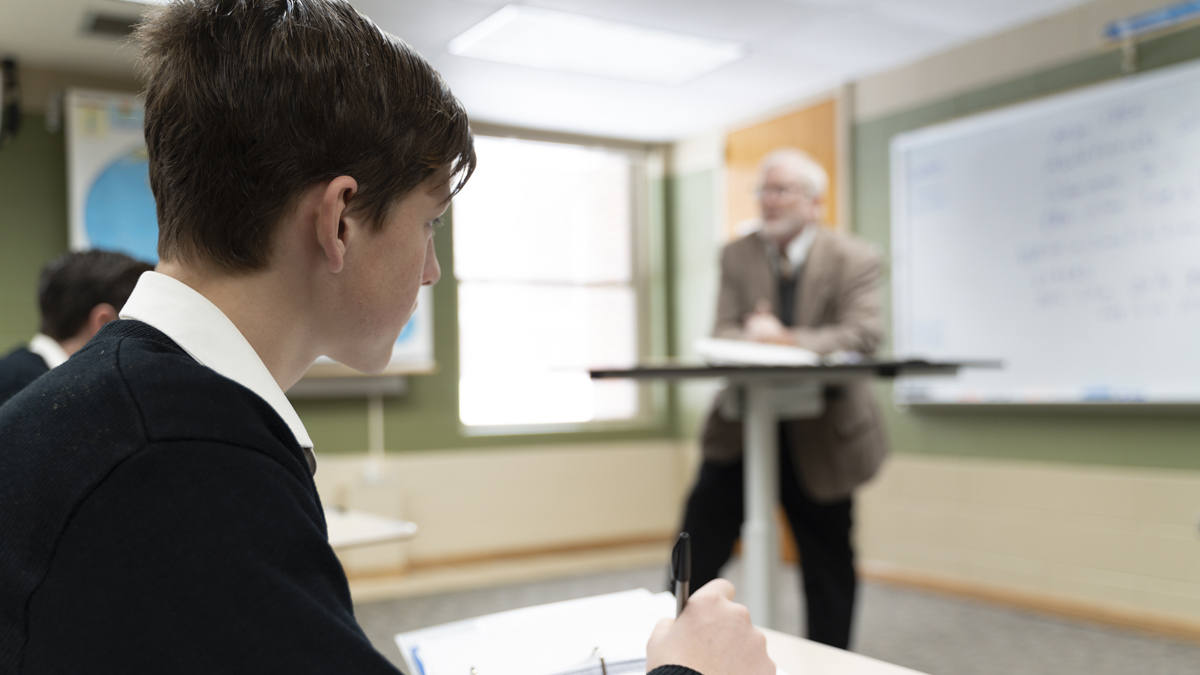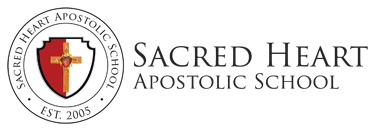
American Literature
This course provides a survey of American literature. This cross-section allows students to see how American literature found its way from colonial essays and speeches to the unique literary styles and themes of modern times. Students construct a canon of writers and works representing the best of American literature from the colonial period through the 20th century. This course also promotes practical vocabulary building in preparation for the SAT. Regular attention to spelling, language mechanics, and critical thinking permeate the general content areas.
Geometry
This course introduces the student to the certitude of demonstrative knowledge. In a study of the first six books of Euclid’s work, The Elements, students use the logical arts of defining, enunciating and reasoning to define, construct, and prove the properties of linear and plane figures. In books I through IV, Euclid investigates the figures in terms of simple equality and inequality. After proving the properties of ratio and proportion in book V, Euclid considers the figures using proportionality in book VI. When time permits, students begin a study of solid geometry in books XI and XII of The Elements.
Chemistry
This course will build on the chemistry learned in Physical Science. It will involve the study of matter and its makeup, going from atoms to complex compounds. The periodic table will be big, both specifically in regards to names and symbols, as well as property trends across the families of elements. Chemical equations and reactions will be explored and learned, as well as the properties of solutions, with a focus on acid/base chemistry. Proficiency in calculating moles, molecular weight, and numbers of atoms will be expected. A section on organic chemistry will be touched on as time allows. The labs will require formal lab reports, including analysis and percent error calculations. Calculators will be allowed.
World History III
This course treats modern history from the perspective of the American and French revolutions as defining political events and the industrial revolution as the great socio-economic force of the era. It begins with the social, philosophical, economic, and political factors of the Western world of the 18th century and proceeds to a study of 19th century Europe and the Americas through the lens of France’s upheavals. Likewise, the history of the East is treated from the perspective of its relations to the Western World due to nationalism and industrialism. The 20th century begins with a more than customary emphasis on WW I as an effect of the 19th century and its impact on the 20th century. The course ends with the significant changes that took place in Africa and the East as a result of the two world wars.
Latin
Students are now ready to translate original works of the great Roman authors. They begin reading, translating, and commenting on Virgil’s Aeneid, and, at the same time, reviewing once again all of the grammar as they come across it in the text. They learn the principles of Latin poetry, especially the dactylic hexameter line used in the Aeneid. Tests include scansion of verses and translation of short unseen passages, as well as longer passages that have already been studied.
Spanish
The core of this class is to introduce and accustom the students to the pronunciation and conversational aspects of the Spanish language by listening to native speakers and reinforcing what they learn through visual helps and explanations. The method used is the Pimsleur audio series, along with supplementary grammatical explanations. Students study the vocabulary they learn in the lessons on Quizlet, and are evaluated using quizzes on Quizlet.
Greek I
The class is an introduction to the essential elements of Greek New Testament grammar with the ultimate goal of enabling the student to read the New Testament in its original language. Using the Basics of Biblical Greek by William D. Mounce, students are introduced to the Greek language beginning with the alphabet, and then learning the forms of nouns, adjectives, and verbs, as well as basic Greek syntax. Each chapter gives the student about 15-20 new vocabulary words chosen from the most frequently used words in the New Testament. At the end of each vocabulary list, the book offers the student an encouraging assessment of his progress in building vocabulary by reminding him of the number of New Testament words he has learned to date and the percentage of all words he knows in the New Testament. By Chapter 35, the final chapter of the book, he will have seen 80 percent of all New Testament words in his vocabulary lists. Each chapter has an accompanying exercise lesson using New Testament verses in which the student translates from Greek to English, practicing what he has learned in the corresponding chapter.
Religion
This class covers the history of the Roman Catholic Church from its origins to its rise as the dominant religion in the Roman Empire. Focusing on primary texts, the course will trace the development of Christian thought, community, and politics in the first 400 years of Christian history. We then explore the Church from late antiquity through the 15th century, with emphasis on trends in spirituality as well as institutional development. Continuing through the 16th century through modern times, the focus is on the Church’s dealing with ideas stemming from the Enlightenment and issues unique to modern times.
Physical Education
Daily physical education is an essential part of the Sacred Heart Apostolic School program. We believe that sports provide not only the physical and mental rest necessary for the student’s balanced growth but also the opportunity to form character and virtue and to thoroughly enjoy one’s growing abilities. At least one hour a day is allotted for intramural soccer, basketball, hockey, football, volleyball, and other sports.
On alternating Saturdays, the students have a chance to enjoy nature off campus at local parks or work on the grounds around the campus.
Music
The students begin their year-round study of classical music in the Summer Course. They begin with an introduction to the instruments of the orchestra and some musical forms. The course is cyclic, and over a three-year span covers the Middles Ages, Renaissance, the Baroque Period, the Classical Period, and the Romantic Period. Audiovisual presentations are the prime medium used to familiarize the students with the music as well as to cultivate an appreciation for the various styles.

